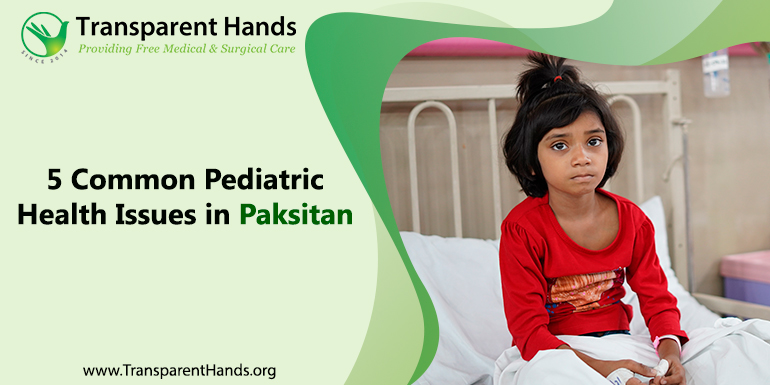Five common pediatric health conditions in Pakistan

Pediatric diseases can vary from country to country. As a developing country, Pakistan also faces many pediatric diseases. Here, we will only discuss the most prevalent pediatric diseases reported in our hospitals.
1. Diarrhea
Diarrhea involves loose and watery stools. It is one of the most common diseases that lead to hospitalizations among pediatric patients. It is usually caused by bacterial, viral, or parasitic infections.
Causes
Unhygienic food is a major cause of diarrhea. There can also be some other causes such as food intolerances and the use of medicines like antibiotics. Antibiotics cause disturbances in the microbes of the gastrointestinal tract. Some people are intolerant to some types of foods like lactose, gluten, and soy. Whenever they consume foods containing these ingredients, they suffer from diarrhea. Inflammatory conditions like irritable bowel syndrome (IBS) also cause diarrhea. Due to varying causes of diarrhea, it is treated according to the cause.
Role of Rehydration in the Management of Diarrhea
Dehydration is a major complication associated with diarrhea and it can even be fatal. An increase in fluid intake is very important in managing diarrhea. Doctors often prescribe oral rehydration solutions to manage dehydration in diarrhea.
Prevention
- Take care of hygiene
- Ensure clean germ-free food and drinking water
- Always wash hands before eating
Worst and Good Foods to Eat When Diarrhea
2. Typhoid
Typhoid or enteric fever is a life-threatening bacterial infection. If it goes untreated it can cause perforation of the intestine and internal bleeding, consequently causing the patient’s death.
Causes
Typhoid is caused by bacteria called Salmonella typhi and Salmonella paratyphi. They get into the human body usually by contaminated food. Typhoid is also more prevalent in populations where people don’t practice good hygiene.
Symptoms
Typhoid symptoms include high-grade fever, constipation, diarrhea, loss of appetite, red spots on the skin, severe headache, and malaise. If typhoid is treated inadequately, it even causes perforations in the intestine.
Prevention
- Always eat hygienic food
- Get vaccinated against typhoid fever
- Always drink well-treated water
- Wash hands frequently
Typhoid Fever in Developing Countries
3. Flu
Influenza commonly known as flu is a very contagious viral infection. Children are more sensitive to it.
Symptoms
Its symptoms appear very suddenly and become better with time. However, if it becomes complicated it might even be fatal. Complications of flu include pneumonia. The characteristic signs and symptoms include cough, sore throat, fever, and chills. Children may also feel uncomfortable while sleeping if they develop chest congestion. Flu also causes loss of appetite in children.
Red Alerts in Flu
There are some emergency signs of flu that include blue lips, difficulty in breathing, and seizures. Immediate medical attention must be sought in case such signs and symptoms appear in children.
Preventions
- Maintain personal hygiene
- Avoid contact with people who are already sick
- Use sanitizers and wash hands
4. Pneumonia
Pneumonia is a lung inflammation due to infection. It could be due to viral, bacterial, or fungal infection. It can affect one or both lungs. Air sacs present in lungs filled with pus or fluids and cause difficulty in breathing. Most pneumonia cases can be treated by simple oral medication. In case of further complications, it can even be fatal.
Symptoms
The classical symptoms of pneumonia include cough with phlegm, difficulty in breathing, chills fever, and shortness of breath. While coughing and breathing, the patient feels chest pain. Children often show restlessness, difficulty in breathing, and lack of energy during this infection.
Types of pneumonia
Pneumonia is classified into various classes, depending on the nature of the causative agent and the place from where you contract the infection.
Community-acquired pneumonia
It is the most common type of pneumonia which is contracted anywhere from the community, except a hospital or healthcare facility. Community-acquired pneumonia can be caused by viruses, bacteria, fungi, or mycoplasma.
Hospital-acquired pneumonia
Patients can also get their lungs infected during a hospital stay due to other health-related problems and this type of pneumonia is termed hospital-acquired pneumonia.
Preventions
- Get your children vaccinated
- Take care of personal hygiene
- Wash hands frequently
5. Chickenpox
Chickenpox is a very contagious infection. A virus named varicella – zoster virus causes it. It mostly affects children but adults can catch it too. Children below the age of two are more susceptible to catching this infection.
Symptoms
The characteristic symptom of chickenpox is an extremely itchy rash with pink-colored blisters all over your body. Chickenpox also causes fever, weakness, loss of appetite, and irritation in children.
Prevention
- Children should be vaccinated against chickenpox
- Avoid direct contact with infected persons
Bottom Line
Most of the diseases that are prevalent in the Pakistani pediatric population can be prevented by vaccination and practicing basic hygiene. Transparent Hands hold medical camps all across Pakistan to provide free consultations and diagnostic tests to deserving patients, including women and children. We also provide free pediatric surgeries. Support our mission and donate to this cause now.










Leave a Reply